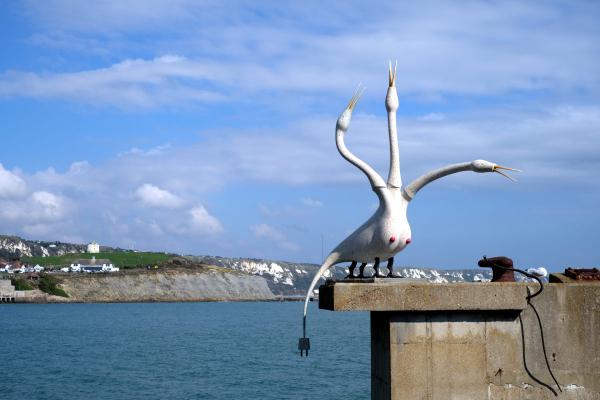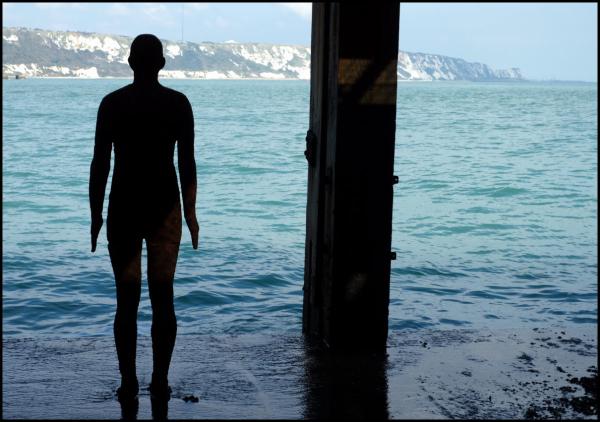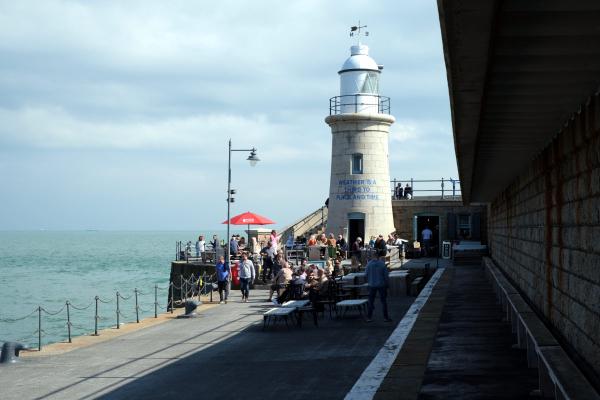Drove down to Folkestone yesterday with spouse. The weather was mostly warm and sunny. We walked along the beach, through the Lower Leas Park, up the zig-zag path, along the top and back down some steps to the Harbour Arm. Plenty to see there. Traders cabins for artists and makers to sell their work. Loads of food and drink outlets. A few art installations.

Laure Prouvost’s Above Front Tears, Oui Connect is a striking three-headed bird rising from the sea - part stone, part glass, part mystery. Its form captures the fluid motion of water and the weight of the land, standing between worlds and inviting us to explore what lies beyond borders and time.
Standing between sea and sky, this bird acts as a guardian of borders and change. Its three heads suggest movement and transformation, like the frames of a video stretched and rearranged to create new rhythms and stories.
This sculpture is part of a trio, linking Folkestone with the Belgian and French coasts at De Panne and Dunkirk. Together, the birds form a playful network that crosses borders and tides, reflecting the shared landscapes and cultures close to the artist’s heart.
With a mix of tenderness, humour and concern for our planet, Above Front Tears, Oui Connect invites us to rethink how we live. What if we could all move freely, float across borders, and imagine new ways to connect with the world? The work offers a hopeful and poetic vision that feels both solid and dreamlike.

Antony Gormley Another Time 1999-2013
Another Time is a series of one hundred solid cast-iron figures, destined by the artist to be dispersed around the world. For Folkestone Triennial 2017, Gormley loaned three from the series, two sited in Folkestone and one, in a collaboration with Turner Contemporary, in Margate in front of the Gallery. Thanks to extension of the loan, the figure in the half tide loading platform on Folkestone’s Harbour Arm, remains on view.
The artist intends the sculptures in this series to “bear witness to what it is like to be alive and alone in space and time” and to “celebrate the still and silent nature of sculpture. The work is designed to be placed within the flow of lived time.” The movement of the tides is a primordial figures here stand within the ebb and flow of the tide, and at times are partly inundated.
Antony Gormley is widely acclaimed for his artworks that investigate the relationship of the human body to space, developing the potential in sculpture since the 1960s through critical engagement with his own and other’s bodies. His work confronts fundamental questions of where human beings stand in relation to nature and the cosmos. Gormley continually tries to identify the space of art as a place of becoming in which new behaviours, thoughts and feelings can arise.

A granite tower The Pier Head Lighthouse was built between 1897 and 1904 as part of the widening and extension of the Outer Pier (the Harbour Arm) to allow larger boats to dock outside the shallow harbour. A simple, pale granite tower two storeys high, raised on a low granite plinth, topped with a metal and glazed lantern and a weather vane.
The lighthouse is tucked into the pier wall at the base of a curved flight of granite steps. Here a polished red granite plaque commemorates the founding of the lighthouse: ‘This pier was commenced by the South Eastern Railway Company on 28th January 1897 and completed by the South East and Chatham Railway Company on 12th July 1904, Coode Son and Matthews Engineers, William Rigby Contractors.’
We ate in The Goods Yard, the Harbour Arm’s street food plaza. I had a baked potato with cheesy beans. Spouse had chicken chowmein. A Bavarian-themed OomPah band made a bit of a din in the background.